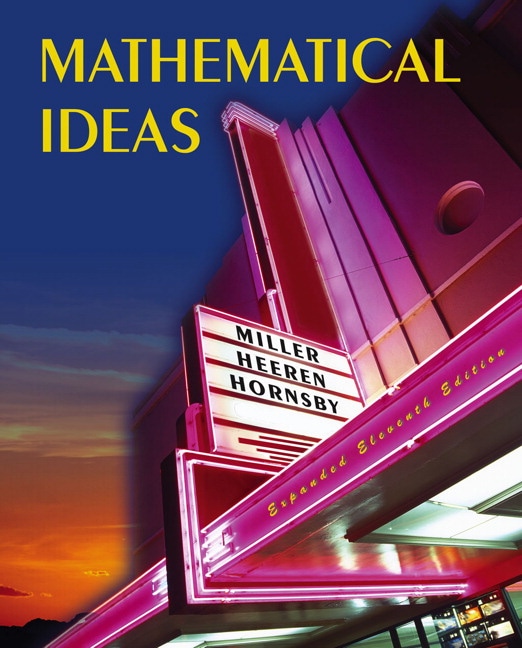
30.00$ - Purchase this E-book
Category : Higher Education
1 The Art of Problem Solving 1.1 Solving Problems by Inductive Reasoning 1.2 An Application of Inductive Reasoning: Number Patterns 1.3 Strategies for Problem Solving 1.4 Calculating, Estimating, and Reading Graphs Extension: Using Writing to Learn About Mathematics Collaborative Investigation: Discovering Patterns in Pascal’s Triangle Chapter 1 Test 2 The Basic Concepts of Set Theory 2.1 Symbols and Terminology 2.2 Venn Diagrams and Subsets 2.3 Set Operations and Cartesian Products 2.4 Surveys and Cardinal Numbers 2.5 Infinite Sets and Their Cardinalities Collaborative Investigation: Surveying the Members of your Class Chapter 2 Test 3 Introduction to Logic 3.1 Statements and Quantifiers 3.2 Truth Tables and Equivalent Statements 3.3 The Conditional and Circuits 3.4 More on the Conditional 3.5 Analyzing Arguments with Euler Diagrams Extension: Logic Problems and Sodoku 3.6 Analyzing Arguments with Truth Tables Collaborative Investigation: Logic Problems and Sodoku Revisited Chapter 3 Test 4 Numeration and Mathematical Systems 4.1 Historical Numeration Systems 4.2 Arithmetic in the Hindu-Arabic System 4.3 Conversion between Number Bases 4.4 Clock Arithmetic and Modular Systems 4.5 Properties of Mathematical Systems 4.6 Groups Collaborative Investigation: A Perpetual Calendar Algorithm Chapter 4 Test 5 Number Theory 5.1 Prime and Composite Numbers 5.2 Selected Topics from Number Theory 5.3 Greatest Common Factor and Least Common Multiple Extension: Modern Cryptography 5.4 The Fibonacci Sequence and the Golden Ratio Extension: Magic Squares Collaborative Investigation: Investigating an Interesting Property of Number Squares Chapter 5 Test 6 The Real Numbers and Their Representations 6.1 Real Numbers, Order, and Absolute Value 6.2 Operations, Properties, and Applications of Real Numbers 6.3 Rational Numbers and Decimal Representation 6.4 Irrational Numbers and Decimal Representation 6.5 Applications of Decimals and Percents Extension: Complex Numbers Collaborative Investigation: Budgeting to Buy a Car Chapter 6 Test 7 The Basic Concepts of Algebra 7.1 Linear Equations 7.2 Applications of Linear Equations 7.3 Ratio, Proportion, and Variation 7.4 Linear Inequalities 7.5 Properties of Exponents and Scientific Notation 7.6 Polynomials and Factoring 7.7 Quadratic Equations and Applications Collaborative Investigation: How Does Your Walking Rate Compare to That of Olympic Race-walkers? Chapter 7 Test 8 Graphs, Functions, and Systems of Equations and Inequalities 8.1 The Rectangular Coordinate System and Circles 8.2 Lines and Their Slopes 8.3 Equations of Lines and Linear Models 8.4 An Introduction to Functions: Linear Functions, Applications, and Models 8.5 Quadratic Functions, Applications, and Models 8.6 Exponential and Logarithmic Functions, Applications, and Models 8.7 Systems of Equations and Applications Extension: Using Matrix Row Operations to Solve Systems 8.8 Linear Inequalities, Systems, and Linear Programming Collaborative Investigation: Living with AIDS Chapter 8 Test 9 Geometry 9.1 Points, Lines, Planes, and Angles 9.2 Curves, Polygons, and Circles Extension: Geometric Constructions 9.3 Perimeter, Area, and Circumference 9.4 The Geometry of Triangles: Congruence, Similarity, and the Pythagorean Theorem 9.5 Space Figures, Volume, and Surface Area 9.6 Transformational Geometry 9.7 Non-Euclidean Geometry, Topology, and Networks 9.8 Chaos and Fractal Geometry Collaborative Investigation: Generalizing the Angle Sum Concept Chapter 9 Test 10 Trigonometry 10.1 Angles and Their Measures 10.2 Trigonometric Functions of Angles 10.3 Trigonometric Identities 10.4 Right Triangles and Function Values 10.5 Applications of Right Triangles 10.6 The Laws of Sines and Cosines: Area Formulas Collaborative Investigation: Making a Point about Trigonometric Function Values Chapter 10 Test 11.1 Counting by Systematic Listing 11.2 Using the Fundamental Counting Principle 11.3 Using Permutations and Combinations 11.4 Using Pascal’s Triangle 11.5 Counting Problems Involving “Not” and “Or” Collaborative Investigation: Solving a Traveling Salesman Problem Chapter 11 Test 12 Probability 12.1 Basic Concepts 12.2 Events Involving “Not” and “Or” 12.3 Conditional Probability; Events Involving “And” 12.4 Binomial Probability 12.5 Expected Value Extension: Estimating Probabilities by Simulation Collaborative Investigation: Finding Empirical Values of π Chapter 12 Test 13 Statistics 13.1 Frequency Distributions and Graphs 13.2 Measures of Central Tendency 13.3 Measures of Dispersion 13.4 Measures of Position 13.5 The Normal Distribution Extension: How to Lie with Statistics 13.6 Regression and Correlation Collaborative Investigation: Combining Sets of Data Chapter 13 Test 14 Personal Financial Management 14.1 The Time Value of Money Extension: Annuities 14.2 Installment Buying 14.3 Truth in Lending 14.4 The Costs and Advantages of Home Ownership 14.5 Investing Collaborative Investigation: To Buy or to Rent? Chapter 14 Test 15 Graph Theory 15.1 Basic Concepts 15.2 Euler Circuits 15.3 Hamilton Circuits and Algorithms 15.4 Minimum Spanning Trees Collaborative Investigation: Finding the Number of Edges in a Complete Graph Chapter 15 Test 16 Voting and Apportionment 16.1 The Possibilities of Voting 16.2 The Impossibilities of Voting 16.3 The Possibilities of Apportionment 16.4 The Impossibilities of Apportionment Collaborative Investigation: Class Favorites, An Election Exploration Chapter 16 Test Table of Contents
Get Mathematical Ideas Expanded Edition, 11th Edition by Charles D. Miller, American River College Vern E. Heeren, American River College John Hornsby, University of New Orleans


0 commentaires:
Enregistrer un commentaire